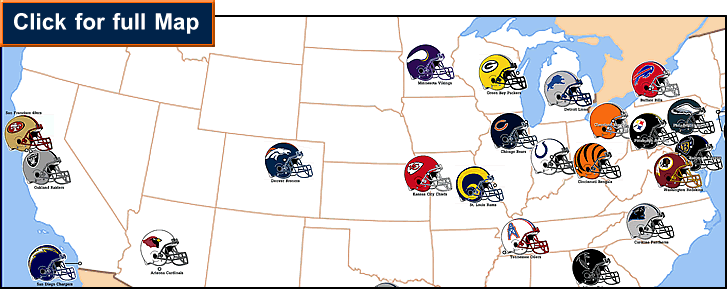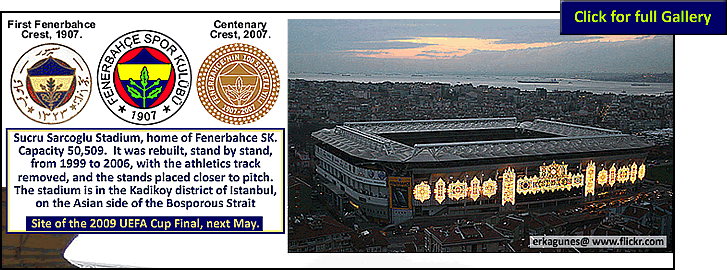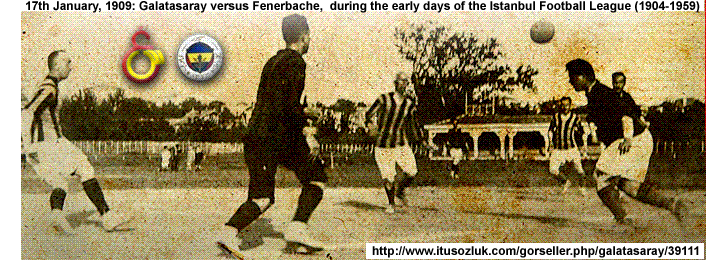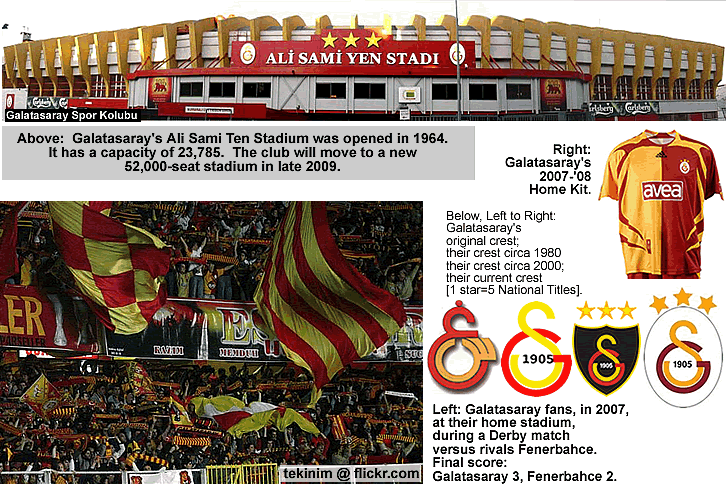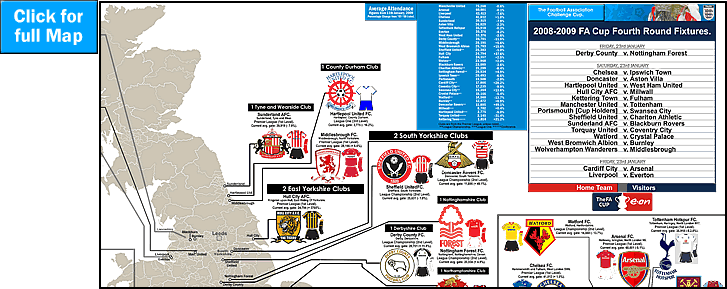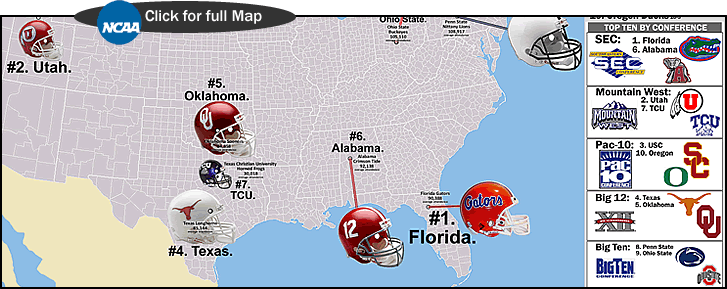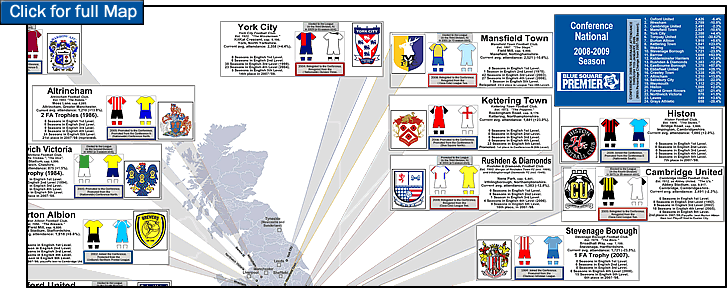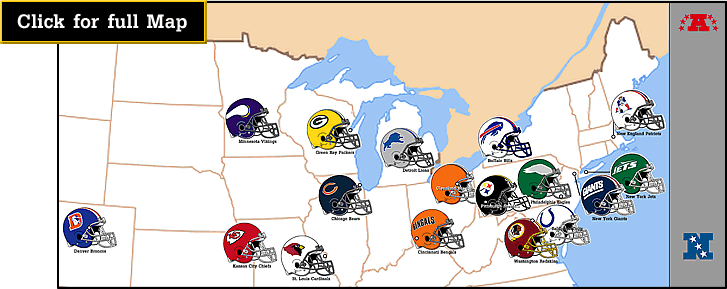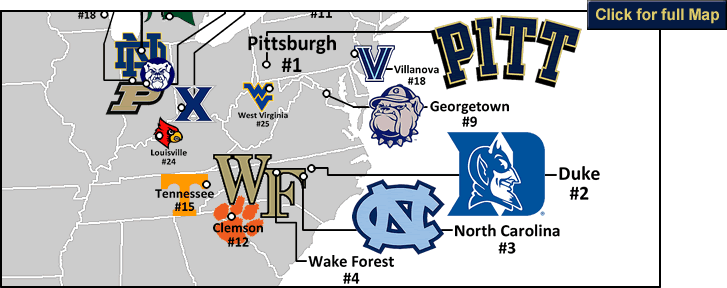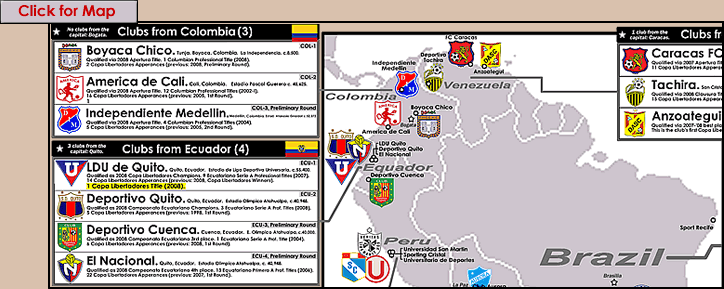
The Copa Libertadores can be viewed as the Champions League of South America (plus Mexico). However, it is a far more grueling ordeal for the clubs than the Champions League. The competition is shoe-horned into a 4-month period (as opposed to the 9-month span of each Champions League season), with travel far more problematic. Modern airports and efficient travel routes are far less prevalent than in Europe. The 2009 Copa Libertadores is the 50th edition of the tournament. 34 of the 49 Copa Libertadores Titles have been won by clubs from the 2 dominant nations of South America: Argentina (21 Titles) and Brazil (13 Titles). But not last year.
Defending Champions are Ecuador’s LDU Quito (Wikipedia page, {Click here} ). They were a surprise finalist, and took Brazil’s Flumenese to penalties after the second leg’s regular time was finished, with the aggregate score at 5-5. LDU Quito’s goalkeeper Jose Francisco Cevallos made three saves on Fluminese penalty kicks, and the unheralded club from the small equatorial nation won the shootout 3-1. It was the first Copa Title by a club from Ecuador. Here is an article on the shock win, from the Guardian.co.uk site, from 4th July, 2008… {Click here}.
-
The Preliminary Round of the Copa Libertadores features 12 clubs. They were drawn into two-legged match-ups. The 6 winners are determined on aggregate goals, with European-style away goals rule in effect (since 2005). If the aggregate is level, there is no extra time…it’s straight to a penalty shootout. The 6 tie-winners advance to the first round, which is the Group Stage {see the 8 groups, here }.
[The Final has different rules for aggregate goals, though. Away goals are not doubled, and there is a half-hour AET, before the penalty shootout, if necessary.]
Match-ups…{Click here (Foxsports) }.
El Nacional (Ecu.) v. Nacional (Par.) 1st leg, 27 Jan.
Universidad de Chile (Chi.) v. Pachuca (Mex.) 1st leg, 28, Jan.
Independiente Medellin (Col.) v. Peñarol (Uru.) 1st leg, 28 Jan.
Palmeiras (Bra.) v. Real Potosí (Bol.) 1st leg, 29 Jan.
Sporting Cristal (Per.) v. Estudiantes (Arg.) 1st leg, 29 Jan.
Deportivo Anzoátegui (Ven.) v. Deportivo Cuenca (Ecu.) 1st leg, 29 Jan.
The 12 clubs in the 2009 Copa Libertadores Preliminaries: [Note: unless otherwise noted, populations are from the Mongabay site {Click here}, and are 2002 estimates.]
Deportivo Anzoátegui (Venezuela). A very new club, established in 2002. The club has no titles, and this is their Copa Libertadores debut. From Puerto la Cruz, which is part of the metropolitan area of Barcelona, Venezuela (metro pop.: 607,000). Kit: yellow, with red trim.
Deportivo Cuenca (Ecuador). Relatively new club, established in 1971. Won their only National Title in 2004. Cuenca is the third largest city in Ecuador (metro pop.: 417,000). Third Copa Libertadores appearance in 5 years. Kit: red, with black.
El Nacional (Ecuador). The football club of the Equadorian military, they were founded in 1964. Tied with Barcelona Sporting Cub for the most National Titles, 13 (their last in 2006). From the capital, Quito (metro pop.: 2,686,000). Kit: all red, with blue trim.
Estudiantes (Argentina). From La Plata, the capital city of Buenos Aires Province (metro pop.: 833,000). Glory days were four decades ago, when the club won 3 straight Copa Libertadores Titles (1968-’70). Won their 4th Argentine Professional Title in 2006 (and their first in 23 years) under then-manager Diego Simeone, who built that team around Juan Sebastián Verón (who had returned after 11 years in Europe). Verón is still on the squad, which finished in 7th in the 2008 Apertura. [Note: qualification in Argentina for some of the spots in the Copa Libertadores is based on league form over one and a half seasons.] Kit: red/ white vertical stripes on jersey; black pants. Nickname: los Pincharratas (the Rat Stickers), for the plethora of rodents in their old ground.
Independiente Medellin (Colombia). Dubbed “El Ponderosa de la Montaña” (the powerful of the mountain). Had a great run in the early part of this decade, with Nationbal Titles in 2002-II and 2004-I, as well as a third-place finish in the 2003 Copa Libertadores. First Copa appearance since ’05. Medellin is the third largest city in Colombia (metro pop.: 2,994,000). Kit: red jersey, blue pants.
Nacional (Paraguay). A club that has three spells in the second division in the last 30 years. Their last of 6 National Titles was in 1946. Nicknamd La Academia, for it’s good youth system. Like most of the Paraguayan top tier, Nacional is from the capital, Asuncion (metro pop.: 1,600,000 [2005 estimate, from MSN Encarta]). Kit: white jersey, blue pants.
Pachuca (Mexico). The oldest pro club in Mexico, from Pachuca, Hidalgo state, which is 88 km east of Mexico City (55 miles). Nicknamed Tuzos (Gophers), the club has had a remarkable last decade, with 5 National Titles (last, Clausura 2007), and 3 CONCACAF Champions League Titles (2002, ’07, and ’08). This after years (prior to 1998) of yo-yoing between the 1st and 2nd divisions. According to Wikipedia (page on Mexico, here), Pachuca is the 31st largest city in Mexico (metro pop.: 439,000 [2005 census]). Kit: blue and white vertcal striped jersey, white pants.
Palmeiras. (Brazil). From Brazil’s largest city, Sao Paulo (metro pop.: 18,505,000). A 2004 survey found Palmeiras to be the 4th-most-supported club in the country, with 11.8 million fans {you can see the whole list (plus a zoom map of 2008 Brazil Campeonato Serie A clubs), in this post, from last May: Click here}. Founded in 1914, as Palestra Italia, by members of the city’s Italian community (the club changed their name during WW II). Palmeiras have won 4 Campeonato Serie A Titles (the last in 1994), and 1 Copa Libertadores Title, in 1999. They just missed out on the 2008 Brazillian Title (won by Sao Paulo for the third straight season), and recently had their manager, Vanderlei Luxemburgo, attacked and injured by supporters {see this (from a blog on the FourFourTwo site) }. Kit: all green.
Peñarol (Uruguay). From the capital, Montevideo (metro pop.: 17,223,000), as are almost all top flight clubs in Uruguay (13 of the 16 clubs are from Montevideo, currently). Peñarol vie with Nacional for the position as the biggest club in the country. A 2006 survey showed that 45% of Uruguayan fans supported Penarol, while Nacional had 35%. Peñarol has won 5 Copa Libertadores Titles. Peñarol won the first 2 Copa Libertadores competitions, in 1960 and ’61. Their fifth and last Copa Title was in 1987. The club’s origins were as an off-shoot of the Central Uruguay Railway Cricket Club, in 1913. Kit: black and yellow vertical stipes on jersey: taken from the colors used on railway signs and warning barriers.
Real Potosí (Bolivia). Bolivia is the ugly stepchild of South American football…no Bolivian club has advanced past the Group Stage (1st Round) of the Copa Libertadores in 8 years. Real Potosí is a club that dates back to 1941, but was wound up in 1985, and re-launced in 1994. Potosí (metro pop.: 136,000) is claimed to be the city with the highest elevation in the world (at 4,090 meters or 13, 420 feet…that’s 2 and a half miles). The club has won 1 National Professional Title (2007 Apertura [Feb.-June]). Kit: purple jersey, white pants (and their logo is so close to Real Madrid’s as to be a copyright infringement).
Sporting Cristal (Peru). From the capital, Lima (metro pop.: 7,604,000), the club’s original name was Sporting Tobacco (talk about an oxymoron). Cristal is a brand of beer. The club has won 15 National Titles, third most in Peru. Kit: sky blue jerseys, white pants.
Universidad de Chile (Chile). From the capital, Santiago (metro pop.: 5,637,000). The well-supported club has the second most National Titles, with 12 (last: 2004-Apertura), but 16 less than Chilean giants Colo Colo. Nickname is los Chunchos (the Owls). Kit: all blue.
-
Notes: 1. In the category of Appearances, the ’09 competition is counted as an appearance. Also, being eliminated in the Preliminary Round still counts as an appearance (the RSSSF site {see this page}uses this protocol, so I am following suit {RSSSF home page, here}).
2. In the category of Titles Won, only professional titles are listed. River Plate (of Argentina) have 1 amatuer title to add to their 33 pro tiles; Boca Juniors have 7 amatuer titles to add to their 24 pro titles; Estudiantes have 1 amatuer title to add to their 4 pro titles. Penarol (of Uruguay) have 10 amatuer titles to add to their 31 pro titles; Nacional (of Uruguay) have 11 amatuer titles to add to their 30 pro titles. Libertad (of Paraguay) have 4 amatuer titles to add to their 9 pro titles. Universiario Deportes (of Peru) have 7 amatuer titles to add to their 17 pro titles.
3A. Some countries have Apertura and Clausura titles that stand on their own as national titles. Argentina is the best example of this; Mexico, Colombia, Chile and Bolivia also use this system, and Paraguay has just adopted this system. 3B. Uruguay, Ecuador, Peru, and Venezuela have a playoff format between the Apertura and Clausura winners to decide the season’s champion. 3C. {Click here (Wikipedia)} and see the second paragraph to determine what part of the year the Apertura and Clausura are played. Yes that’s right…in certain parts of South America, “apertura” and “clausura” have the opposite meanings. This is just the tip of the iceberg, unfortunately, of the dysfunction endemic to the game on this continent. Thankfully, the Copa Libertadores itself is only getting bigger and stronger (and more important to clubs), as the years go by.
Thanks to the contributors to the pages on the Copa Libertadores at Wikipedia {Click here}.
Thanks to Sam Kelly at the Hasta El Gol Siempre site {Click here} (and also at ESPN Soccernet [Sam Kelly at ESPN Soccernet archive here]), for fact-checking and input. Sam will be writng about the Copa on my next post on the competition, which will be just before the Group Stage begins on 11th February.
